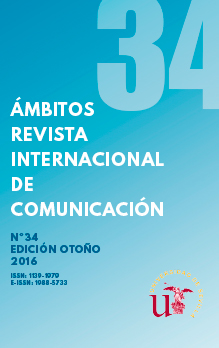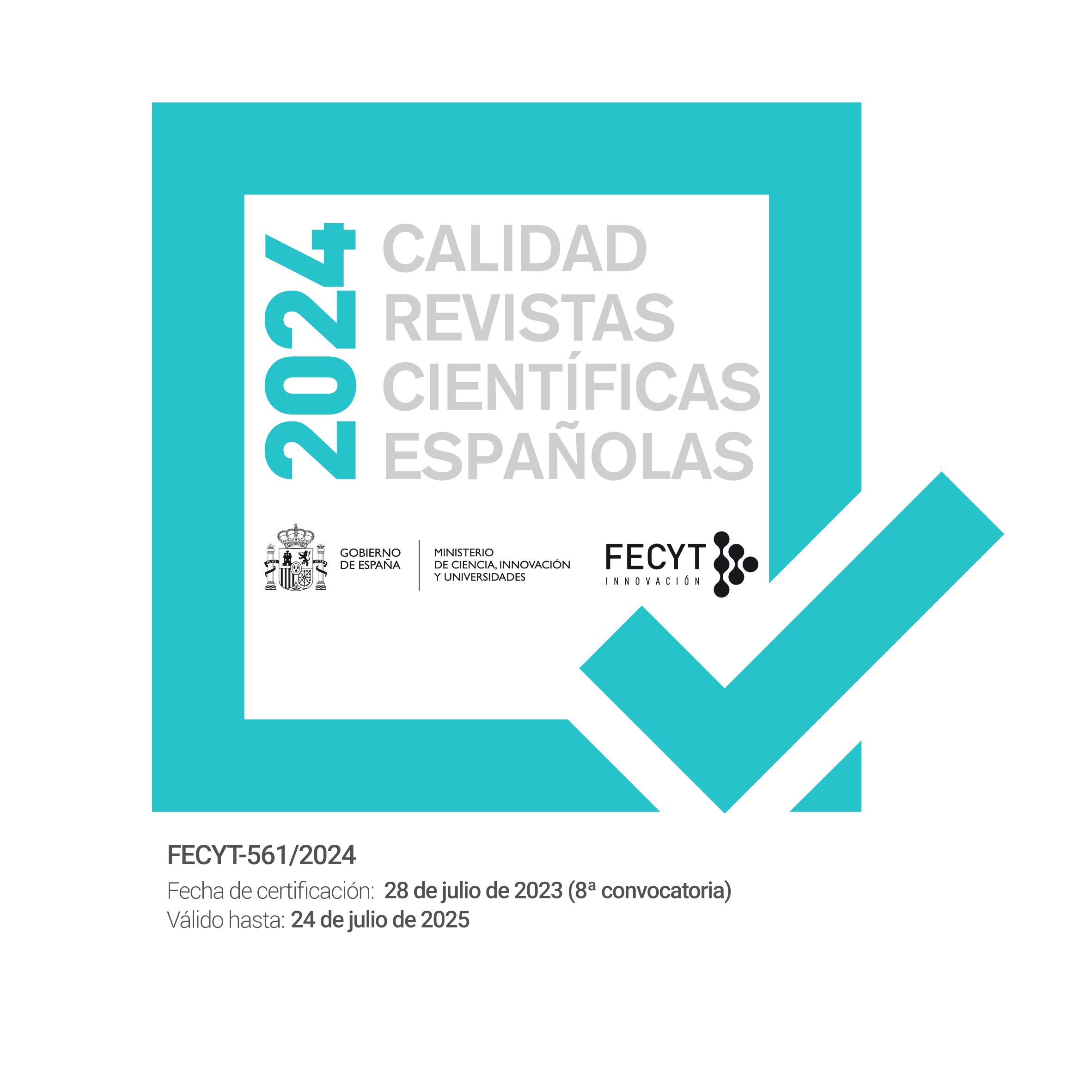La 'mirada femenina': estereotipos y roles de género en el cine español (1918-2015)
Palabras clave:
Roles, estereotipos, género, cine español, mirada femenina. Roles, stereotypes, gender, female gaze, filmmaking, spanish cinema.Resumen
La incorporación de la mujer al mercado laboral ha sido un proceso largo no exento de dificultades. La mujer en la industria del cine constituye un ejemplo paradigmático en la atribución de roles, tanto en lo referente al acceso asimétrico a la dirección, como en su representación en la gran pantalla. A las dificultades generales, en España se añaden las circunstancias coyunturales de un siglo XX marcado por una situación político-social que retrasó aún más el acceso de la mujer al trabajo y que lastró un imaginario androcéntrico que llega hasta nuestros días. Las pocas mujeres que se han dedicado al cine en puestos de dirección, han tenido que hacer frente a un aluvión de dificultades que se han materializado en reducción de presupuesto, así como falta de confianza en su trabajo y en su competencia. Al mismo tiempo, la presencia de mujeres detrás de la cámara siempre dispara la cuestión de “la mirada femenina”, lastre prototípico que homogeniza la labor de todas las cineastas y que reduce a estereotipos su diversidad. De la mano de los estudios de Sandra L. Bem, en este trabajo nos proponemos descubrir si el sexo de los directores determina su mirada, así como si la asunción de un estilo de trabajo responde a motivos sexuales per se a un rol social.
The incorporation of women at work has been a long and difficult process. Gender roles and the ‘manifest destiny’ of women have prevented them from integrating the active part of society. Women in the motion-picture industry constitute a paradigm in attributing gender-roles, both in the asymmetric access to filmmaking and creating stereotypes. These difficulties are evident in the Spanish film industry, where in addition to general conditions the socio-political context delayed even more the insertion of women in the labour market. During decades, the very few women directors have had to face not only a fierce androcentric imaginary, but also a countless amount of complexities which include inadequate budgets and a lack of confidence in their competence. Simultaneously, the presence of women behind the camera raises the question about the so-called ‘female gaze’, which determines the polarization of professionals in terms of gender. This stereotypical burden is not only a homogenization of their work, but also a pejorative consideration about their creativity. Therefore, the goal we aim to achieve is to diagnose the status of women in cinema, especially in the Spanish motion-picture industry, as well as to discover if the gender of filmmakers per se determines their gaze.
Descargas
Citas
Alfonso, M. (2012): National Flames and Embers: ‘Con la vida hicieron fuego’, Jesús Evaristo Casariego’s Novel (1953) and Ana Mariscal’s Film (1957). ARBOR Ciencia, Pensamiento y Cultura.
Vol. 187-758. 1087-1106. doi:10.3989/arbor.2012.758n6008
Arranz, F. (2010): Cine y género en España. Madrid: Cátedra.
Arreaza, E. (2008): Las cineastas como escritoras en el cine venezolano contemporáneo.
Karibay. 49-53. Mérida: Universidad de Los Ándes.
Barra Almagiá, Enrique (2004). Validación de un inventario del rol sexual construido en Chile.
Revista Latinoamericana de Psicología, vol. 36, núm. 1. Bogotá: Fundación Universitaria Konrad
Lorenz. Pp. 97-106
Bem, Sandra (1994): The Lenses of Gender. Transforming the Debate on Sexual Inequality.
New Haven, CT: Yale University Press.
Bem, Sandra L. (1998): An Unconventional Family. New Haven, CT: Yale University Press.
Benavent, F. (2000): El cine español de los 90. Diccionario de películas, directores y temático.
Bilbao: El Mensajero.
Berger, J. (1972): Ways of Seeing. London: Penguin.
Bryson, N. (1988): The Gaze in the expanded field. In Foster, H. (ed): Vision and visuality.
New York: The New Presses.
Camí-Vela, M. (2014): Directoras de cine en Cataluña: un recorrido histórico.
Zeitschrift für Katalanistik, 27 (2014), 27–45. Frankfurt am Main: TFM.
Castejón, M. (2004). Mujeres y cine. Las fuentes cinematográficas para el avance de la historia de
las mujeres. Berceo, nº 147, 303-327. Logroño: Instituto de Estudios Riojanos.
Castejón, M. (2010) 25 años de cine. Muestra Internacional de Cine y Mujeres de Pamplona.
Pamplona: Ipes Elkartea.
Catalán, E. (2014): Hollywood echa a las mujeres del negocio. El confidencial. Los Ángeles.
de diciembre. Obtenido de http://www.elconfidencial.com/cultura/2014-12-09
/hollywood-echa-a-las-mujeres-del-negocio_579515/
Cixous, H. (1976). The Laugh of the Medusa. Signs, Vol. 1, No. 4. 875-893. Chicago:
The University of Chicago Press
Cruz, J (2003): Las mujeres en el ojo de la cámara (de cine). La historia no contada: mujeres pioneras.
Albacete: Ayuntamiento de Albacete. Retrieved from www.ciudaddemujeres.com/…/pdf/
LasMujeresEnElOjoDeLaCamara.pdf
Cuadrado, I; Morales, J.F.; Moya, M.; Gaviria, E. (2007). Psicología social. 3rd Edition Madrid:
McGraw-Hill.
Follows, Stephen (2016). “Cut Out Of The Picture: A Study Of Female Directors In The UK Film
Industry”. London: Directors UK.
Freud, Sigmund (1997): General Psychological Theory. New York: Touchstone.
Friedan, B. (1963): The Feminine Mystique. New York: W.W. Norton & Company, INC.
García, R. (2014). Cine contra viento y marea. El País, 19 septiembre. Obtenido de http://cultura.elpais.com/cultura/2014/09/16/babelia/1410883562_857589.html
García Mainar, L. (1997). Mulvey´s alleged avoidance of essentialism in Visual Pleasure and
Narrative Cinema. Atlantis, XIX (2).114-123.
García, C. (2007). El cine con mirada femenina. Crítica. Nº 943. 65-69. Madrid: Editorial Crítica.
García Rodrigo, J. (2010): Directora de Producción de El Deseo, Esther García: “no hay cine de
mujeres o de hombres; sólo hay cine y si es bueno, mejor”. Quaderns de cine, 5, 37-41. Alicante:
Universidad de Alicante.
Gemmell, N. (2014): The new female gaze is shocking for its novelty and audacity. The Australian,
de mayo. Obtenido de: http://www.theaustralian.com.au/news/features/the-new-female-
gaze-is-shocking-for-its-novelty-and-audacity/story-e6frg8h6-1226906389343
Giese, M. (2012). Women Directors: Can We Sue The Studios? Women Directors in Hollywood 6
de noviembre. Obtenido de http://www.womendirectorsinhollywood.com/women-directors-
can-we-sue-the-studios-2/
Harding, S. (1987). Feminism and Methodology. Bloomington, Indianapolis: Indiana University Press.
Heredero, Carlos F. (1999). 20 nuevos directores del cine español. Madrid: Alianza.
Iglesias, N. (1994): El placer de la mirada femenina. Género y recepción cinematográfica.
Frontera Norte. Vol. 6, Nº. 12, 93-110. Tijuana: Colegio de la Frontera Norte.
Iglesias, A. (2014). Escudos humanos con cuerpo de mujer. El País, 13 de octubre. Obtenido de http://elpais.com/elpais/2014/09/30/planeta_futuro/1412098529_791065.html
Jacobsson, Eva-Maria (1999): A Female Gaze? CID-51. Stockholm: Royal Institute of Technology,
Numerical Analysis and Computing Science.
“Josefina Molina” (2013). El Diario de Córdoba, 11 de noviembre. Obtenido de: http://www.eldiadecordoba.es/article/ocio/1644120/josefina/molina/afirma/pp/lo/le/
gusta/es/cine/americano.html
Krips, H. (2010): The Politics of the Gaze: Foucault, Lacan and Žižek. Culture Unbound.
Volume 2, 2010: 91–102. Linköping: University Electronic Press.
Lemire, Christy (2007): Women directors shine; numbers still low. USA Today, 8 de enero. Obtenido de: http://usatoday30.usatoday.com/life/movies/2007-08-01-1773314053_x.htm
Lerner, Gerda (1990) La creación del patriarcado. Barcelona: Crítica.
Martínez, M. (2008). Women on the other side of the camera. Where are the Women Cinema
Directors? Espacio, Tiempo y Forma, Serie VII, Hª del Arte, 20-21, 2007-2008, 315-340.
Madrid: UNED.
Mulvey, L. (1999). Visual Pleasure and Narrative Cinema. Film Theory and Criticism. 833-44.
Introductory Readings. Eds. Leo Braudy and Marshall Cohen. New York: Oxford UP
Mujeres y cultura. Políticas de igualdad (2013). Informe del Ministerio de Cultura. Madrid:
Ministerio de Cultura. Secretaría General Técnica.
Melchiori, Paola (1992): El cine de las mujeres. Una mirada a la identidad femenil.
Debate feminista, 3. Vol. 5. Debate Feminista: México D.F.
Miranda, M. (2006): Mujeres cineastas argentinas jóvenes. Tesina de Grado. Buenos Aires:
Universidad de Buenos Aires.
Mulvey, Laura (1975). Visual Pleasure and Narrative. Cinema Screen 16.3 Otoño, 6-18.
Glasgow: Oxford University Press.
Núñez, T. (2010): Female Movie Directors: a challenge, a hope. Pixel-Bit. Revista de Medios y
Educación. Nº 37. Julio-diciembre, pp: 121 – 133.
Penley, C. (ed.) (1988). Feminism and Film Theory. New York: Routledge.
Pontes, R; García and Nirave, C. (2014). Las actrices españolas reivindican su espacio. El País.
de diciembre. Obtenido de http://smoda.elpais.com/articulos/la-nueva-generacion-de
-actrices-espanolas/5709
Smith, S., Pieper, K., Choueiti, M. (2013). Sundance Institute and Women In Film Los Angeles
Study Examines Gender Disparity in Independent Film. Sundance Institute.
Obtenido de http://www.sundance.org/festivals/sundance-film-festival.
Soto, M. (2004): Vivir antes de morir. Las 12, 2 de abril. Obtenido de:
http://www.pagina12.com.ar/diario/suplementos/las12/13-1114-2004-04-05.html
Taff, Heidi P. (2003). Times Have Changed? IABC Research Foundation´s ‘The Velvet Ghetto’
Study Revisited. Communication World. February-March.
Tarín, F. (2001): El cine como (re)productor de imaginarios: la doble trama de representación e
imposición de un modelo genérico. II International Congress of AUDEM. Valencia:
Universidad de Valencia.
Tejedor, Esther (2013): España se rueda en masculino. El País, 12 de diciembre. Obtenido de: http://sociedad.elpais.com/sociedad/2013/12/13/actualidad/1386966463_447257.html.
Torres, P. (2004): Mujeres y cine en América Latina, Guadalajara: Universidad de Guadalajara,
Guadalajara.
Villén, M. (2014): La mirada femenina arraiga en Egipto con un festival de cine único en la zona.
La Información, 02/12/14. Obtenido de: http://noticias.lainformacion.com/arte-cultura-
y-espectaculos/cine/festival-de-cine/
Von Trotta incide en la necesidad de una mirada femenina para equilibrar el cine.
El diario de Córdoba. Noviembre 2014. Obtenido de: http://www.eldiadecordoba.es/article/ocio/1905356/von/trotta/incide/la/necesidad
/una/mirada/femenina/para/equilibrar/cine.html
Wilde, O. (1982) [1890]. The Picture of Dorian Gray. Barcelona: Orbis.
Woolf, V. (2008) [1929]. A room of one’s own. 6ª Edición. Barcelona: Seix Barral.
Zecchi, B. (2014). Desenfocadas. Cineastas españolas y discursos de género. Barcelona: Icaria.
Zurbano, B.; Liberia, I. (2014): Theoretical and conceptual review of gender-based violence and its discursive representation on the media. A proposal of resignification.
Zer 19-36, 121-143. Vizcaya: Euskal Herriko Unibertsitatea.
Descargas
Publicado
Cómo citar
Número
Sección
Licencia
Ámbitos. Revista Internacional de Comunicación es una revista de acceso abierto, lo que significa que todo su contenido está disponible gratuitamente para el usuario o su institución. Los usuarios pueden leer, descargar, copiar, distribuir, imprimir, buscar o enlazar con el texto completo de los artículos, o utilizarlos para cualquier otro fin lícito, sin solicitar permiso previo al editor o al autor. Esta definición de acceso abierto se ajusta a la Iniciativa de Acceso Abierto de Budapest (BOAI).

A menos que se indique lo contrario, todo el contenido de la edición electrónica se distribuye bajo una " licencia internacional Creative Commons Attribution-NonCommercial-ShareAlike 4.0 ". Puede consultar la versión informativa y el texto legal de la licencia aquí. Esto debe indicarse expresamente de esta manera cuando sea necesario.
En caso de aceptación del manuscrito, los autores ceden los derechos de la obra para su publicación a Ámbitos. Revista Internacional de Comunicación bajo el contrato de licencia Reconocimiento-NoComercial-CompartirIgual 4.0 Internacional (CC BY-NC-SA 4.0). Los autores conservan los derechos de autor y terceros están autorizados a copiar, distribuir y hacer uso de la obra, siempre que cumplan con los términos y condiciones establecidos en la licencia.
- Citar la autoría y la fuente original de publicación (revista, editorial y URL de la obra).
- No los utilice con fines comerciales.
- Si remezcla, transforma o crea a partir del material, debe publicar sus contribuciones bajo la misma licencia que el original.
Se puede encontrar más información en https://creativecommons.org/licenses/by-nc-sa/4.0/deed.es



















